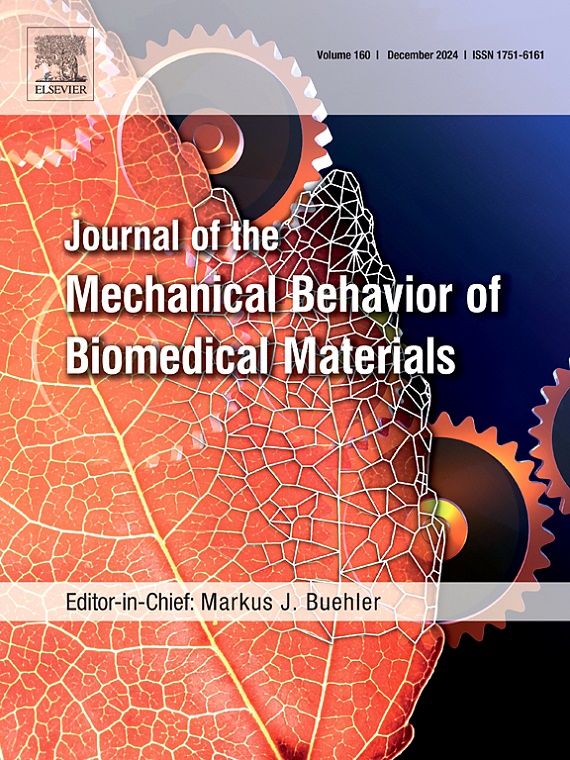Mechanical characterization of a brain phantom material by combining experiments in the time and frequency domain
IF 3.5
2区 医学
Q2 ENGINEERING, BIOMEDICAL
Journal of the Mechanical Behavior of Biomedical Materials
Pub Date : 2025-07-05
DOI:10.1016/j.jmbbm.2025.107114
引用次数: 0
Abstract
Modeling the mechanical behavior of brain tissue complements experimental findings about brain diseases and supports the development of predictive tools for diagnosis. The foundation for a reliable continuum-based model is an accurate and comprehensive experimental characterization of the material. Such a characterization is yet limited by inconsistent or contradicting mechanical responses when using different testing techniques. These inconsistencies mainly result from the ultrasoft behavior and biphasic structure of the tissue, which makes it extremely sensitive to changes in the time and length scales. In this study, an approach is presented to overcome the challenge of inconsistent responses and to unify the results from experiments with varying time scales in a continuum-based model. A viscoelastic hydrogel, validated as a brain phantom material, was experimentally characterized over an extended time range. The quasi-static response was investigated at the rheometer with experiments under multiple loading conditions. The behavior in the mid-frequency range was characterized in a vibration analysis at a custom-built vibration table and the response at high frequencies was studied with magnetic resonance elastography. Moreover, the impact of the testing temperature on the mechanical behavior of the hydrogel was analyzed. A hyper-viscoelastic model was calibrated to the time response conducted at the rheometer. As a material model the hyperelastic Ogden model in combination with the time-dependent Prony series was chosen. By addressing the frequency domain with the relaxation times of the Prony series, the frequency-dependent material behavior was included in the modeling approach. To validate this approach, the experimental responses in the mid and high-frequency range were predicted with the calibrated model. The comparison between the modeled and the measured response revealed an excellent prediction of the elastic material behavior, whereas the viscous response may be underpredicted by the model. The results further highlight that the material is very sensitive to temperature changes and therefore temperature should be taken into account in the comparison of different testing techniques.

在时间和频域结合实验的脑幻影材料的力学特性
对脑组织力学行为的建模补充了关于脑部疾病的实验发现,并支持了诊断预测工具的发展。一个可靠的基于连续体的模型的基础是对材料进行准确和全面的实验表征。当使用不同的测试技术时,这种表征仍然受到不一致或矛盾的机械反应的限制。这些不一致主要是由于组织的超软行为和双相结构,这使得它对时间和长度尺度的变化非常敏感。在本研究中,提出了一种方法来克服响应不一致的挑战,并在基于连续体的模型中统一不同时间尺度的实验结果。一种粘弹性水凝胶,被验证为脑幻影材料,在延长的时间范围内进行了实验表征。在流变仪上通过实验研究了多种加载条件下的准静态响应。在定制的振动表上进行了中频范围的振动分析,并利用磁共振弹性成像研究了高频范围的响应。此外,还分析了测试温度对水凝胶力学性能的影响。在流变仪上进行的时间响应校准了超粘弹性模型。选择了超弹性Ogden模型和随时间变化的proony序列相结合作为材料模型。通过利用proony级数的松弛时间对频域进行寻址,将频率相关的材料行为纳入建模方法。为了验证这一方法,用校准后的模型预测了中频和高频范围内的实验响应。模型响应与实测响应的比较表明,模型对弹性材料性能的预测很好,而粘性响应可能被模型低估。结果进一步强调了材料对温度变化非常敏感,因此在比较不同的测试技术时应考虑温度。
本文章由计算机程序翻译,如有差异,请以英文原文为准。
求助全文
约1分钟内获得全文
求助全文
来源期刊

Journal of the Mechanical Behavior of Biomedical Materials
工程技术-材料科学:生物材料
CiteScore
7.20
自引率
7.70%
发文量
505
审稿时长
46 days
期刊介绍:
The Journal of the Mechanical Behavior of Biomedical Materials is concerned with the mechanical deformation, damage and failure under applied forces, of biological material (at the tissue, cellular and molecular levels) and of biomaterials, i.e. those materials which are designed to mimic or replace biological materials.
The primary focus of the journal is the synthesis of materials science, biology, and medical and dental science. Reports of fundamental scientific investigations are welcome, as are articles concerned with the practical application of materials in medical devices. Both experimental and theoretical work is of interest; theoretical papers will normally include comparison of predictions with experimental data, though we recognize that this may not always be appropriate. The journal also publishes technical notes concerned with emerging experimental or theoretical techniques, letters to the editor and, by invitation, review articles and papers describing existing techniques for the benefit of an interdisciplinary readership.
 求助内容:
求助内容: 应助结果提醒方式:
应助结果提醒方式:


